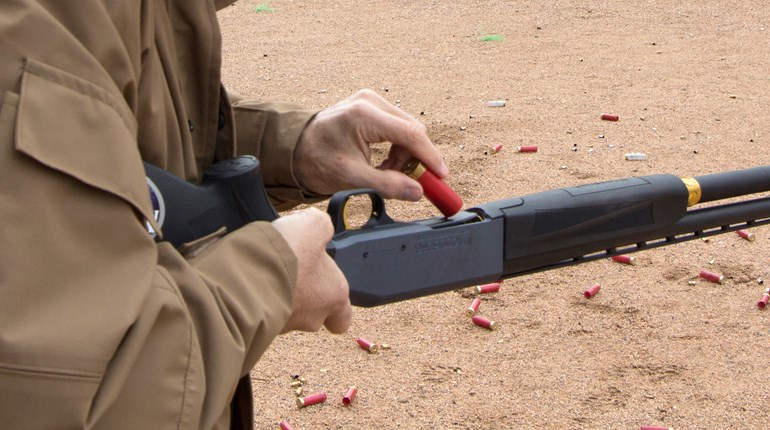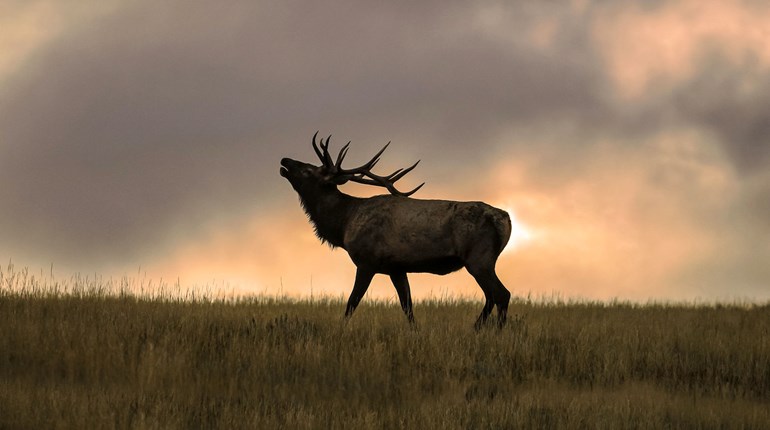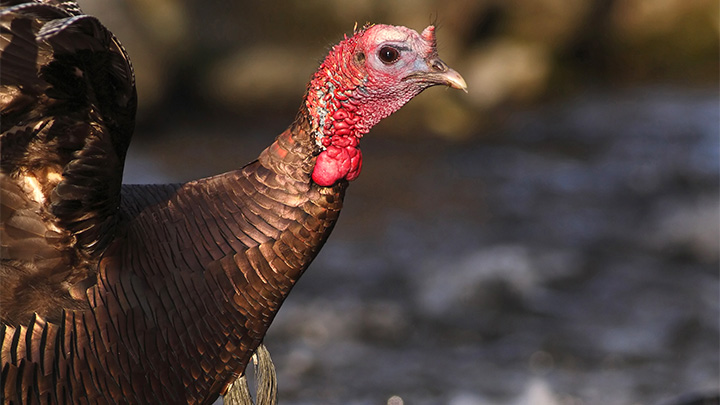
I knew I’d hear gobbles on this particular morning because I’d roosted a whole flock of birds the evening before. The old owner of the farm pointed his grubby farmer’s finger and assured me I’d find birds “on the crick in the middle of that oak holler” and that “only a no-huntin’ city-slicker could hunt in there and not bring home a bird.”
Uh huh, I thought. I’d heard that kiss of death before.
But sure enough, I walked to the edge of the woods at 6:30 p.m. and gave an owl hoot that started a chain reaction of gobbles on down the row of cottonwoods lining the creek. That’s all I needed to hear, so I quietly slipped back to my truck and drove home, feeling great about my chances for the morning.
So back I was at 5:30 a.m., wondering exactly where to set up. I didn’t want to get too close and spook them, so I set up just inside the woods, probably 150 yards from the creek and from them.
As I sat watching the sky’s black turn to gray, I resisted the urge to call. In my experience I’ve learned not to call much, if at all, while the birds are still in the trees and not yet talking—and I can’t really tell you why. It just seems like more times than not, if I hammer them while they’re on the roost they’ll fly the other way when they do decide to fly down. So I waited.
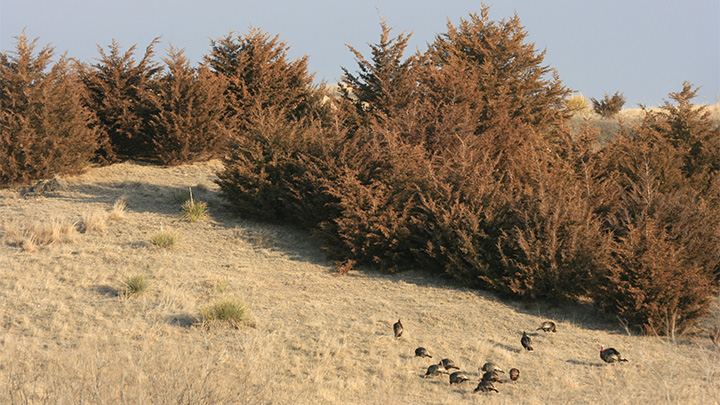
Finally, I heard the soft call of a hen, but she didn’t get finished before a booming gobbler cut her off; then another gobbler cut him off and then another. Four or five gobblers were in there still, and I was sitting pretty. About 10 minutes 'till official shooting time, I let out a tiny—I mean barely audible—tree call. It was cut off by the gobblers. Now they knew where I was, and my confidence soared. (I envisioned them racing and fighting each other to see who could get to my awaiting shotgun barrel first.)
As the last minutes until legal shooting light ticked away, I leveled my shotgun on my knee, popped in my favorite mouth call like a chaw of tobacco and readied my slate just under my left thigh. But I doubted I’d need it, as hot as these birds were.
And then, suddenly, I heard the unmistakable flapping, whooshing and feathers-scratching-on-wood sound of a large creature flying down from the roost. Then I heard another, then another and another. Then a boss hen gave a long, raspy yelp, followed by one gobble. The birds were on the ground, that much I knew for sure, and the game was officially on.
So I gave a raspy yelp and waited. Nothing. I gave another one. Nothing.
Uh oh. So I picked up my slate call and gave a loud, desperate-sounding cutt. Nothing. Maybe they were headed toward me, silently, like they do sometimes.
About five minutes later I heard a gobble, but just barely. It was at least twice as far away as it had sounded on the roost. And then I heard another, even farther. Rats! The birds had gone in the complete opposite direction! And to make matters worse, I didn’t know if they’d flown across the creek—and I didn’t know if I could physically cross the creek or if I even had permission to hunt the other side! I tried to text the landowner to ask, but he didn’t reply.
So I walked around that morning, calling and setting up in random spots for a few hours before skulking back to my truck and going home, feeling like … well, a no-huntin’ city slicker. I’d thought it was going to be so easy, what with all the gobblers around, that I’d failed to scout much or even ask detailed questions about the birds or the land. And that was my downfall.
While nobody can outwit wild turkeys all the time—and that’s what makes hunting them fun—great turkey hunters are often successful because they’ve learned the three secrets of turkey hunting: thorough scouting, perfect setup location and timely calling. Here’s what you need to know.
Scouting
Thorough scouting involves three main aspects: 1. Knowing turkeys exist where you hunt; 2. learning the land; and 3. determining the turkeys’ typical travel patterns.
It may sound obvious, but in order to kill a turkey, at least one must be available to kill. Spend time scouting properties in the offseason so you don’t waste time hunting a birdless property during the season. (For more detailed instructions on how to thoroughly scout for gobblers, click here.)
In my case, had I simply asked the farmer to outline his property boundaries on a map then studied the property by walking it before the season, or at least looking at a topo map, I would have known the creek was crossable in a few places, and if there were any known turkey hangouts on the other side.
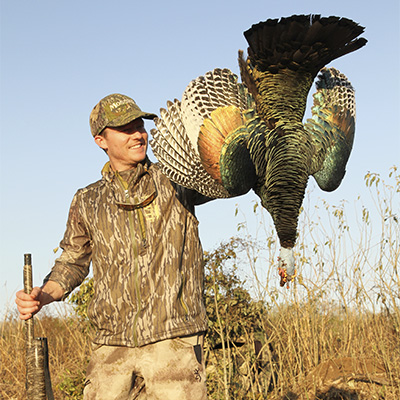
You see, the most important aspect of calling in any animal is not so much the cadence, tone and timing of your calls but knowing where the animal actually wants to go. If you can predict where turkeys want to go and be in that spot before they arrive, you’ll amaze yourself and your buddies on how expert you’ll become as a “caller.” Predicting where gobblers go after they leave the roost isn’t so much like reading the cards or throwing bones; rather, if left undisturbed, turkeys will often roost in the same trees, dust in the same fields and feed and travel in similar patterns each day. If you know this via detailed scouting, trail cams or intel gleaned from landowners prior to hunting, then you’ll be successful more times than not. But to do this, you must scout thoroughly.
Perhaps there is no finer example of scouting for success than in Campeche, Mexico, where the ocellated turkey dwells. The ocellated is beautiful with its bedazzled, peacock-like tail feathers, and it’s most definitely a turkey—except it doesn’t gobble and the hens aren’t very vocal, so they can’t be called consistently. In order to take them on the ground as these turkeys go about their non-gobbling lives, guides must not only know where a big ocellated turkey lives and what crop field it prefers, but what edge of the field it frequents and on what limb he likes to rest his wary head. Even then it’s a hit-or-miss deal, but without scouting it would be an absolute crapshoot. After four days of trusting my guide’s scouting, a lone tom picked its way around a millet field silently, just long enough for me to nail him with a dose of TSS shot from my Mossberg. The whole ordeal in Mexico really opened my eyes to the fact that gobblers don’t have to gobble, nor do you even have to call them in to kill them—if your knowledge of the land and a gobbler is keen.
Setup Location
After you’ve scouted thoroughly, know the lay of the land and have a good idea of where turkeys like to roost and how they travel, picking a good setup location is key. As a general rule, you should try to get as close to birds on the roost as possible while erring on the side of caution to prevent spooking them. Typically, this means getting within 100 yards of gobbling birds before setting out a decoy. In areas of less cover, this distance might be 150 or even 200 yards.
Secondly, using your knowledge of the land, where the turkeys are roosted and their travel patterns, try to get between the birds and their feeding or dusting spots. As mentioned, it’s much easier to call a turkey in the direction he’s already headed than to convince him to turn 180 degrees to check out some strange hen.
Third, if you have little or no clue which way the turkeys will head after leaving the roost, don’t get too committed to one spot. Stay mobile; don't put out a decoy or blind. Then, if the gobbler decides to fly down in the opposite direction from you, determine which way he’s headed by listening, then beat feet by doing a big loop around him. When you feel like you’re ahead of him, set up, but don’t call until you hear him and feel like he's within 150 yards or so. If he sounds like he's switched directions again, make another loop and repeat the process. While all this moving might sound aggressive, it’s not that risky, provided you use terrain features like creeks and woods to shield your movement.
If you simply can’t get ahead of the birds, remember your ace in the hole, your knowledge of where the birds roost. You can always come back and set up near the roost in the evening with fairly good confidence they’ll eventually be back.
Smart Calling
Volumes can be written on the intricacies of calling turkeys based on the terrain, the type of turkey and the time of year. But in general, it’s best not to overcall. It’s also usually best to leave a bit of curiosity in the gobbler’s head, which is to say play a little hard to get.
I try to call on my time rather than let a gobbler dictate the terms. If he gobbles, I’ll wait 30 seconds or more to answer him. When I do call again, plenty of times he’ll cut me off. Then I’ll wait a little while longer, give a sharp cutt then shut up. Countless times a hot gobbler can’t stand this sassy hen, and he’ll come in fast.
On the other hand, birds that are not as hot to breed—and especially old, wary Eastern toms—must be slow-played. This means clucking more with light yelps and putts rather than hammering their ears with cutts and long yelps. It’s best to listen to these gobblers to let them tell you what they want. If a tom is cutting you off and double- and triple-gobbling, he’s hot and you can call more aggressively; if he’s gobbling occasionally and seemingly randomly, he’s either not all that hot or he’s already found an enticing hen.

If you have called for 45 minutes and the bird is hung up or even sounds to be going away, don’t hesitate to gather your gear and, as previously mentioned, make a big, fast loop around him. Use an owl call to track his whereabouts as you move. Then, when you get close to him again but from another angle, set up swiftly and try yelping again. Often this change of angle will entice him to come in.
If a gobbler is really close but just won’t come those last few yards, it may mean he’s hot enough to come halfway but wary enough to want confirmation. Try reaching down and scratching the leaves—or having a buddy do it behind you. Often this will entice him to close the distance.
But if you just can’t get him to come in, don’t toss in your hat and do something foolish that might spook him. After he goes away, silently back out then come back the next day. Chances are he hasn’t gone far, and by then it might just be his day to die.
The Rest of the Story
When I returned home that day, I called the farmer. After making fun of myself for being a terrible turkey hunter, I asked a few more questions.
“I’ll tell you a secret,” he said, in typical farmer fashion. “There’s a big clover field across the crick where I see ’em dang near every day. If you’da asked me, I would’a told ya.” Yea, thanks, farmer man, as if I knew to ask about a secret clover field.
Anyway, the following morning, rather than setting up near the roost and calling 'till I became dizzy, I took a play out of my Mexican guide’s playbook. I simply walked all the way around the woods, crossed the creek and set up on the edge of the clover field that I found easily by looking at Google Earth on my phone.
As dark turned to light, I heard the entire flock sound off from the same roost trees as the morning before. This time, I didn’t make a peep. Eventually they flew down, and sporadically I heard a hen or a gobbler. This time they were coming closer. Finally, at about 8 a.m., six hens entered the field followed by two jakes, and then three huge boss gobblers, all strutting as they toed the clover. And you know what happened next.
■ ■ ■
Remington 870 410 Turkey and Federal TSS Load
While a .410-bore is not my first choice as a dedicated turkey gun, if you’re really serious about killing a turkey, hunting with a .410 sure is fun! It’s like using a traditional bow rather than a modern compound when bowhunting, which is to say you must rely more on pure hunting skill rather than the efficiency of the tool in your hand.

While not offering the max range of a magnum 12-gauge, this .410-bore brings several things to the table. First, it’s extremely light and fun to carry. Secondly, it has very little recoil. And lastly, it’s great for squirrels and other small game after turkey season ends. It runs about $699. For more information, visit remington.com.
Loaded with Federal’s incredible (and expensive, at $34.99 for five rounds) Heavyweight TSS .410 load featuring almost 300 No. 9 pellets that strike with the energy of No. 7s, the little .410 is actually deadlier than you might think; it has a viable max-gobbler-range out to 40 yards. For more information, visit federalpremium.com.












